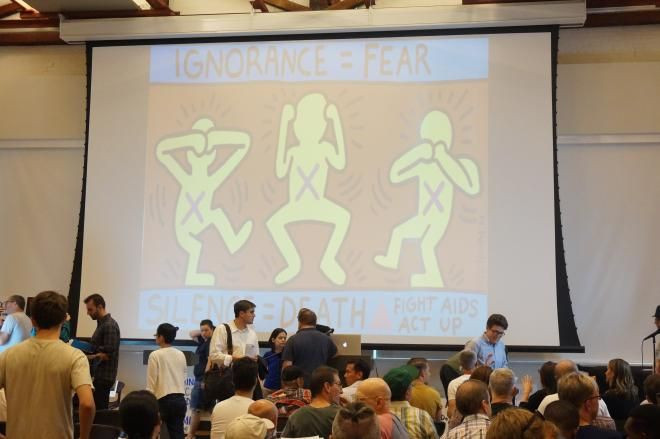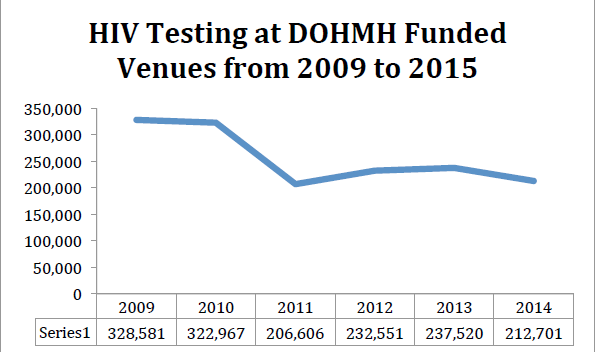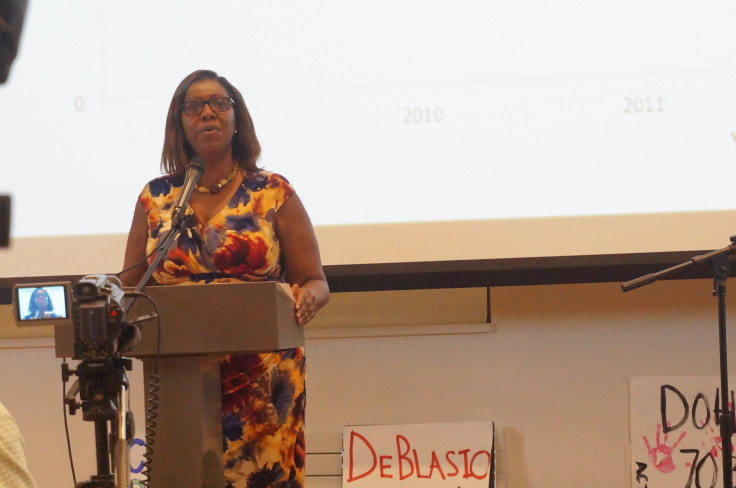As STD Clinics In NYC Lose Funding, STD Rates Are Shooting Back Up And Local Communities Are Angry

Last week, James Krellenstein, a member of the HIV advocacy organizations ACT UP NY and the Treatment Action Group (TAG), released a report that purported to show the growing lack of sexual health services provided by the New York City Department of Health and Mental Hygiene (DOHMH), using data both publically available and given to him by the DOHMH.
Since 2010, the amount of money spent by the DOHMH on free HIV testing and other sexual health services has been dramatically reduced. And in March, one of the most populated publically-owned STD testing clinics situated in Chelsea, Manhattan was shut down until 2017, pending renovations — similar shutdowns have occurred over the past four years, with only one clinic having since been reopened.
Likely as a result, the number of clinic visits has slowed down from 123,512 in 2010 to 83,025 in 2014; and the number of annual free HIV tests provided by the DOHMH has dropped from around 300,000 to slightly over 200,000. This has coincided with growing rates of sexually transmitted infections in that same time period, with annual cases of gonorrhea in men increasing by more than 40 percent, and syphilis infections in men by about 30 percent, though the number of newly diagnosed HIV infections has remained steady (around 3,000 cases a year) and even slightly decreased since 2010 in NYC.
In the wake of the media attention the report received, the two organizations held a town hall meeting Tuesday night at the Lesbian, Gay, Bisexual & Transgender Community Center, located mere blocks away from the blacked out Chelsea clinic, which Medical Daily attended.

“An Evening That Matters”
The packed auditorium nonetheless made room for health officials from the DOHMH, as well as representatives from the Mayor’s office, with chairs at the front that went unfilled for the entire evening.
According to Jeremiah Johnson of TAG, the official response by the DOHMH is indicative of a long-standing trend toward the LGBT community, historically hit hardest by the HIV epidemic. “Our sexuality has been constantly under attack from all corners of society,” Johnson said. For Johnson and his fellow activists, one of the most egregious actions taken by the DOHMH wasn’t necessarily its shutdown of the Chelsea clinic, but in its decision to avoid communicating with the community before doing so.
No advance announcement of the closing was made to the public, and afterwards, just a small English-language sign that directed people to a uptown clinic in Riverside, 70 blocks away, was left behind. Only after mounting pressure was the sign made bilingual, and later, vans that could provide referral information and a degree of the testing services the Chelsea clinic once did were added near the old site as well. But these options offer much less confidentiality, and are a drop in the bucket compared to the value the clinic provided in an area of the city that is especially at risk of STIs and HIV.
According to Johnson, Chelsea, a historically friendly neighborhood for LGBT individuals, sees three times the rate of new HIV infections and six times the rate of syphilis infections compared to the rest of the city. In 2014, the Chelsea clinic accounted for almost one-fourth of STD clinic visits among DOHMH funded facilities, and since its closure, total visits so far this year have declined 18 percent compared to the same time period in 2014 (4,462).
“STD clinics are still the front line of HIV prevention,” said James Krellenstein at the meeting. According to Krellenstein, the staff at these facilities are now discouraged from testing people who present no symptoms of a STD or, in the case of HIV, had recently been tested in the past three months.

Yet, carriers of STDs such as syphilis and gonorrhea are often asymptomatic, and Krellenstein believes that the lowered rates of HIV testing have led to worse HIV detection. Even accounting for the possibility that 50 percent of people who would have received free HIV testing at a clinic were able to go elsewhere to obtain the test, his report estimates conservatively that 1,000 more HIV positive test results between 2010 to 2014 would have been caught had the DOHMH budget stayed level.
“The end is in sight. Science has delivered the answers,” Krellenstein said, referring to research showing that increased HIV testing and better prophylaxis access can drive down rates of new HIV infections. “The only question is: Can we force our society to take advantage of them?”
End The Epidemic
For community activists who have combatted the emergence of HIV/AIDS in their neighborhoods for years, if not decades, the “End The Epidemic” (ETE) public health initiative announced by New York State Governor Andrew Cuomo in June 2014 appeared to be a monumental step forward.
Aiming to curb the rate of new HIV infections in the state to under 750 by 2020, the plan would involve broad-sweeping programs that'd identify individuals with undetected HIV; it’d ensure that these individuals received treatment that can suppress their infection and allow them to live long, healthy lives; and it’d aggressively and proactively prevent high-risk populations from ever contracting the disease, not only through providing education, screenings, and appropriate contraceptive methods to those who might not otherwise be able to obtain it, but by making treatments such as Pre-Exposure Prophylaxis (PrEP) and Post-Exposure Prophylaxis (PEP), which require a prescription, more accessible.
Perhaps the most encouraging aspect of the ETE initiative was the spirit of cooperation it fostered, as its accompanying task force formed in October of 2014 was comprised of public health specialists, policymakers, and local community leaders. And the 44 committee recommendations the task force ultimately issued were in part culled from over 300 ideas submitted by the public online.
In a small way, the initiative could have been seen as a means of reconciliation between the LGBT community and the government, whose documented hesitance to acknowledge HIV in its earliest days set research efforts back for years and contributed to the unnecessary suffering and discrimination felt by those afflicted.
It was a renewed promise to safeguard the health of the public, regardless of their station in life or their sexual orientation, and one that now appears empty to many who attended the town hall meeting, and even to some of the city’s government officials.
“It’s about values and priorities,” said NYC’s Public Advocate Letitia James at one point, occupying a position that current mayor Bill de Blasio previously held. “If you're serious about ending HIV by 2020, this is not the way to do it.”

The sentiment was echoed by city councilman Corey Johnson, who has been working to secure funding for a temporary site at the Chelsea location. “If this city with a $78 billion budget wants to take care of a problem, they’ll do it,” said Johnson, noting that a single case of Ebola within city limits last year was able to galvanize the government into spending millions of dollars and countless resources to contain it.
A Reignition Of Old Grievances
For their part, the DOHMH has not stood idly by in the face of the claims made by ACT UP and TAG. “The report is misleading. Mayor de Blasio has added $1.1 million a year for STD clinics to enhance services for men who have sex with men. There was also nearly $4 million in the budget, thanks to the City Council, to end the epidemic,” replied the Health Department in an email to Medical Daily. “The estimated proportion of NYC residents ever tested for HIV has increased. The Chelsea Clinic is only one component of the City’s extensive services for people at risk for STDs and HIV.”
As evidence, they offered data collected by the NYC Community Health Survey from 2007 to 2012, which does indeed show that the rate of people who have ever been tested for HIV is steadily rising. According to them, 95 percent of STD diagnoses in 2014 were made somewhere other than the Chelsea clinic, and 80 percent of Chelsea residents with a STD were diagnosed elsewhere. “The Chelsea Clinic is important, but a temporary closure to support renovation, combined with extensive auxiliary services during the renovation, will not hinder the City’s ability to end the AIDS epidemic.”

They went on to note that rates of syphilis and gonorrhea have been increasing in urban areas worldwide since 2000, with their rise being tied to a number of complex factors. And that the vast majority of STD diagnoses are made in the private health care sector, and not through the Health Department’s clinics.
Though the DOHMH is right to point out that many people have access to sexual health services through their insurance plans, it’s those at the marginalized fringes of society that most rely on their publicly funded health care. Of the 2,832 new HIV cases found in 2013, two-thirds were diagnosed in black and Hispanic individuals, and more than half resided in a neighborhood with a high or very high poverty level.
Councilman Johnson acknowledged that the DOHMH has had to deal with severe budget cuts imposed on it by the previous administration, losing as much as $200 million in funding for STD services during that time period. And in a response to Krellenstein, which he attached to his report, the Department admitted that it was forced to shut down clinics and cease universal HIV testing due to budget cuts, a measure that was implemented only a few years prior in 2008.
But because of the DOHMH’s perceived lack of transparency over these budget problems, old grievances have been reignited. “This is homophobia and transphobia in terms of public health,” Krellenstein said passionately towards the end of his speech, to the rousing applause of the crowd.
The anger felt by the town hall attendees throughout was palpable, many of the older members no doubt veterans of a time when their needs and concerns were continuously ignored or denied by the powerful.
“Act up! Fight back! Fight AIDS!” shouted audience members at the end of the meeting, repeating a long-held rallying cry by the organization.
It’s a war that they shouldn’t need to fight by themselves anymore.



























